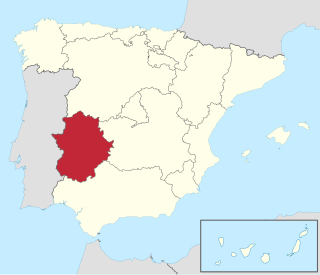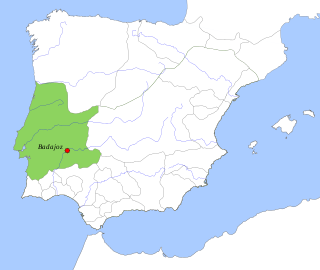
Extremadura is a landlocked autonomous community of Spain. Its capital city is Mérida, and its largest city is Badajoz. Located in the central-western part of the Iberian Peninsula, it is crossed from east to west by the Tagus and Guadiana rivers. The autonomous community is formed by the two largest provinces of Spain: Cáceres and Badajoz. Extremadura is bordered by Portugal to the west and by the autonomous communities of Castile and León (north), Castilla–La Mancha (east), and Andalusia (south).
Abd Allah ibn Muhammad ibn Maslama, surnamed Ibn al-Aftas, was the founder of the Aftasid dynasty of the taifa of Badajoz, in what was then Al-Andalus. He was a miknasa berber from the Córdoba region. Ibn al-Aftas became the vizier of Sabur al-Saqlabi, a former slave of Caliph al-Hakam II, who became prince of the lower march of the former Caliphate of Cordoba. On the death of Sabur in 1022, Ibn al-Aftas seized power, and Badajoz under his leadership, became the capital of a principality centered on Guadiana and extending over central Portugal. He was a prominent military tactician and was surnamed "Al-Mansur". He died about 1045 AD.

The taifas were the independent Muslim principalities and kingdoms of the Iberian Peninsula, referred to by Muslims as al-Andalus, that emerged from the decline and fall of the Umayyad Caliphate of Córdoba between 1009 and 1031. They were a recurring feature of al-Andalus history.
The Aftasid dynasty was an Arabized Iberian-Berber dynasty that ruled the Taifa of Badajoz in Al-Andalus.
Gharb al-Andalus, or just al-Gharb, was the name given by the Muslims of Iberia to the region of southern modern-day Portugal and part of West-central modern day Spain during their rule of the territory, from 711 to 1249. This period started with the fall of the Visigothic kingdom after Tariq ibn-Ziyad's invasion of Iberia and the establishment of the Umayyad control in the territory. The present day Algarve derives its name from this Arabic name. The region had a population of about 500,000 people.

Marvão is a municipality in Portalegre District in Portugal. The population in 2020 was 2,972, in an area of 154.90 km2. The present Mayor is Luís Vitorino, elected by the Social Democratic Party. The municipal holiday is September 8.

The Guadalupe or Guadalupejo is a river in the west of the Iberian Peninsula, a right-bank tributary of the Guadiana, which discharges into the Atlantic Ocean. Its course runs through the Spanish provinces of Cáceres and Badajoz.

The Taifa of Granada or Zirid Kingdom of Granada was a Muslim kingdom that was formed in al-Andalus in 1013 following the deposition of Caliph Hisham II in 1009. The kingdom was centered on Granada, its capital, and it also extended its control to Málaga for a period. Four kings succeeded each other during its nearly 80 years of existence, all of them belonging to an offshoot of the Zirid dynasty of North Africa, a Sanhaja Berber clan. The Taifa of Granada was considered to be the wealthiest out of all of the taifa kingdoms. It was eventually conquered by the Almoravids in 1090, putting an end to Zirid rule in Granada.

The Taifa of Toledo was an islamic polity (taifa) located in the centre of the Iberian Peninsula in the high middle ages. It was ruled by the Dhulnunids, a Hawwara Berber clan. It emerged after 1018 upon the fracturing of the Caliphate of Córdoba, when the Dhulnunids, already strong in the lands of Santaver, Cuenca, Huete and Uclés, seized control over the city of Toledo, the capital of the Middle March of Al-Andalus. Upon later territorial conquest, the taifa also expanded to the land of Calatrava. It lasted until the Christian conquest of Toledo in 1085.

Segura de León is a Spanish municipality in the province of Badajoz, Extremadura. It has a population of 2,170 (2007) and an area of 106 km2. It belongs to the comarca of Tentudía.

The Taifa of Badajoz was a medieval Islamic Moorish kingdom located in what is now parts of Portugal and Spain. It was centred on the city of Badajoz which exists today as the first city of Extremadura, in Spain.
Zawi ibn Ziri as-Sanhaji or Al-Mansur Zawi ibn Ziri ibn Manad as-Sanhaji, was a chief in the Berber Sanhaja tribe. He arrived in Spain in 1000 (391) during the reign of Almanzor. He took part in the rebellion against the Caliphate of Córdoba and settled in the Cora of Elvira with followers from his Sanhaja tribe. He founded the Taifa of Granada, and founded the Zirid dynasty of Granada as its first Emir, reigning from 1013 to 1019.
Mubārak al-Saqlabi and Muẓaffar al-Saqlabi were jointly the first emirs of the Taifa of Valencia between 1010 and 1018. They were brothers and Saqaliba, originally Slavic children that were captured, castrated, sold as slaves in Spain, and educated in the Islamic culture and religion. They became slaves of another slave named Mufaris who was chief of police in the palace of Almanzor in the Medina Azahara.

The Madrid–Valencia de Alcántara line is an Iberian-gauge railway in Spain owned by ADIF. It is one of the main legacy lines across Extremadura and the province of Toledo, serving cities such as Talavera de la Reina and Cáceres. Part of the stretch across the Madrid region is used by commuter service C-5..
Labib al-Fata al-Saqlabi was the founder and first ruler of the Taifa of Tortosa from around AH 400 (1009/1010 CE) to AH 431 (1039/1040). He was a Saqaliba, usually Slavic children that were captured, castrated, sold as slaves in Spain, and educated in the Islamic culture and religion.
Abū Muḥammad ʿAbd Allāh ibn Muḥammad ibn al-Sīd al-Baṭalyawsī, also spelled Ibn Assīd or Abenasid, was an Andalusian grammarian and philosopher. He is the earliest Islamic philosopher from the West whose works have survived.

The Monument to Calvo Sotelo is an instance of public art located in Madrid, Spain. Erected on the south of the Plaza de Castilla, it is dedicated to José Calvo Sotelo, who was assassinated shortly before the outbreak of the Spanish Civil War.

Talavera de la Reina railway station is a railway station serving the Spanish city of Talavera de la Reina, in the province of Toledo.

The Provincial Archaeological Museum of Badajoz or simply the Archaeological Museum of Badajoz is an archaeology museum located in Badajoz, Spain. Owned by the Spanish State, its management has been transferred to the Junta of Extremadura.

The Kūra was one of the territorial demarcations into which al-Andalus, the ancient Islamic Iberian Peninsula, was divided during the Emirate and Caliphate of Córdoba. It coexisted with another territorial demarcation called March ("thagr"), which overlapped the Kūra in the areas bordering the Christian kingdoms. Both underpinned the al-Andalus territorial organization during the aforementioned periods.













